Foxes appear as enigmatic and adaptable creatures across a wide diversity of landscapes. Unlike some creatures that specialize in particular habitats, foxes are versatile beings found in various environments. In this article, we delve into the captivating world of foxes, unraveling their distinctive characteristics, behaviors, and the vital roles they play in the ecosystems they call home.
Diverse Species and Appearance
Foxes belong to the Canidae family, along with dogs and wolves. They boast a wide variety of species spread across the globe. Each exhibits unique traits shaped by its environment.
Adaptations for Survival
Foxes are ground-dwelling mammals with a compact build. Their fur, varying in color and thickness, serves as camouflage in their respective habitats.
The keen sense of hearing and sharp eyesight of foxes make them adept hunters, capable of navigating diverse landscapes in search of prey.
Nocturnal Behavior
Many fox species are crepuscular or nocturnal, meaning they are most active at night, dawn, or dusk. This behavior helps them avoid predators and lowers competition for resources.
Life Cycle and Social Dynamics
Foxes exhibit intriguing life cycles and social structures, showcasing their adaptability and intelligence.
Monogamous Pairs
Foxes are monogamous, typically mating for life. This social structure provides stability and support during the critical periods of raising offspring. The shared responsibility between mates contributes to the survival and well-being of their young.
Vocalizations and Communication
Foxes are vocal animals with a diverse range of calls. From the iconic high-pitched barks to eerie screams, these vocalizations serve various purposes, including territory marking, mating signals, and warning calls. So if you hear someone singing, “What Does The Fox Say,” you can tell them, “A whole lot!”
Family Units
Foxes raise their young in dens, creating a network of interconnected family units. The parents work collaboratively to nurture and protect their offspring. As the young foxes grow, they learn essential survival skills through play and observation.
Physical Description
Foxes display a remarkable range of physical characteristics.
Fur Variation
The fur of foxes varies in color, ranging from red and gray to silver and black. This adaptability allows them to blend seamlessly into their surroundings, providing a distinct advantage in hunting and avoiding predators.
For instance, Arctic foxes have white fur to blend into a snowy backdrop. The red fox, common to woodlands across North America, has a reddish-brown color to blend into the shadows and foliage of the forest floor.
Size
Foxes come in different sizes depending on the species. The smallest, the fennec fox, weighs around 2 to 3 pounds, while the largest, the red fox, can weigh up to 31 pounds. Their size allows them to navigate a wide range of habitats successfully.
Long Tails
Foxes have long, bushy tails, which serve multiple purposes. The tails aid in balance, especially when they are on the move or navigating uneven terrain, and can be used as a warm cover during colder months.
Lifespan and Mating Habits
Foxes have distinct patterns in terms of lifespan and mating habits.
Lifespan
In the wild, foxes typically have a lifespan of 3 to 4 years. However, in captivity, they can live longer; some reach up to 14 years. The challenges of the wild, including predation and environmental factors, contribute to their relatively shorter lifespan.
Mating Season
Foxes have a specific mating season, which varies by species and geographic location. Generally, the mating season occurs in winter, with a gestation period of around 50 to 60 days. Vixens, or female foxes, give birth to a litter of pups, and both parents actively participate in raising them.
Monogamous Bonds
The monogamous bonds formed by foxes contribute to successful reproduction. Mates share responsibilities, from hunting and providing food to protecting the den and caring for the young. This cooperative approach enhances the chances of the pups reaching maturity.
Beyond their ecological significance, foxes have woven themselves into the tapestry of human culture, leaving an indelible mark on literature, television, and music. These enigmatic creatures have captured the human imagination, symbolizing a myriad of qualities from cunning and intelligence to adaptability and resilience.
Cultural Significance of Foxes
In literature, foxes have often been portrayed as elusive and clever characters who are both cunning and wise. Aesop’s fables, with stories like “The Fox and the Grapes” and “The Fox and the Crow,” showcase the fox as a shrewd and resourceful figure. In modern literature, foxes continue to play symbolic roles, representing complex traits and qualities that resonate with readers.
Television has embraced the fox as a charismatic and mysterious character, tool. Animated shows, such as “The Fox and the Hound,” and anthropomorphic characters like “Fantastic Mr. Fox,” contribute to the enduring appeal of foxes. In these portrayals, foxes often navigate challenges with wit and grace, captivating audiences of all ages.
The music world has also embraced the mystique of foxes. Ylvis’s viral hit “What Does The Fox Say” humorously explores the unknown vocalizations of these creatures, turning the fox into an unexpected musical sensation.
The symbolism of the fox extends beyond the fictional realm. In various cultures, the fox is often associated with trickster figures and mythical beings. In Japanese folklore, the kitsune is a fox spirit possessing intelligence and magical abilities. In Native American mythology, foxes are often depicted as clever and adaptable beings.
Foxes, with their cunning strategies, diverse adaptations, and widespread presence, embody the resilience and adaptability of wildlife in the face of changing environments. Unlike some creatures that may specialize in certain habitats, foxes navigate a broad range of landscapes, showcasing their ability to thrive in diverse ecosystems.



